Blast-Induced Compression of a Thin-Walled Aluminum Honeycomb Structure—Experiment and Modeling
Abstract
:1. Introduction
2. Experimental Investigation
2.1. The Generalized Response of Compressed Cellular Metallic Structures
2.2. Description of the Test Set-up-Explosive-Driven Shock Tube
2.3. Quasi-Static Compression of the Honeycomb Structures
3. Validation of the Numerical Simulation
3.1. Numerical Configuration
3.2. Material Model Validation
3.3. Numerical Study
3.3.1. Structure Geometry
3.3.2. Mesh Consistency Study
3.3.3. Friction Influence
4. Numerical Results
5. Conclusions
Author Contributions
Funding
Conflicts of Interest
References
- Suceska, M. Test Methods for Explosives; Springer Science & Business Media: Berlin/Heidelberg, Germany, 2012. [Google Scholar]
- Needham, C.E. Blast Waves (Shock Wave and High Pressure Phenomena); Springer: London, UK; New York, NY, USA, 2010. [Google Scholar]
- Dang, X.; Chan, P.C. Design and test of a blast shield for Boeing 737 over head compartment. Shock Vib. 2006, 13, 629–650. [Google Scholar] [CrossRef]
- Spranghers, K.; Vasilakos, I.; Lecompte, D.; Sol, H.; Vantomme, J. Identification of the plastic behavior of aluminum plates under free air explosions using inverse methods and full-field measurements. Int. J. Solids Struct. 2014, 51, 210–226. [Google Scholar] [CrossRef] [Green Version]
- Tyas, A. Experimental Measurement of Pressure Loading from Near-Field Blast Events: Techniques, Findings and Future Challenges. Proceedings 2018, 2, 471. [Google Scholar] [CrossRef] [Green Version]
- Henshall, B.D. The Use of Multiple Diaphragms in Shock Tubes; No. ARC-CP-291; ARC-18062; Gt. Brit. Aeronautical Research Council: London, UK, 1955. [Google Scholar]
- Lloyd, A.; Jacques, E.; Saatcioglu, M.; Palermo, D.; Nistor, I.; Tikka, T. Capabilities of a shock tube to simulate blast loading on structures. ACI Spec. Publ. 2010, 281, 35–54. [Google Scholar]
- Andreotti, R.; Colombo, M.; Guardone, A.; Martinelli, P.; Riganti, G.; Di Prisco, M. Performance of a shock tube facility for impact response of structures. Int. J. Non-Linear Mech. 2015, 72, 53–66. [Google Scholar] [CrossRef]
- Aune, V.; Fagerholt, E.; Langseth, M.; Børvik, T. A shock tube facility to generate blast loading on structures. Int. J. Prot. Struct. 2016, 7, 340–366. [Google Scholar] [CrossRef] [Green Version]
- Louar, M.A.; Belkassem, B.; Ousji, H.; Spranghers, H.; Kakogiannis, D.; Pyl, L.; Vantomme, J. Explosive driven shock tube loading of aluminium plates: Experimental study. Int. J. Impact Eng. 2015, 86, 111–123. [Google Scholar] [CrossRef]
- Ousji, H.; Belkassem, B.; Louar, M.A.; Reymen, B.; Martino, J.; Lecompte, D.; Pyl, L.; Vantomme, J. Air-blast response of sacrificial cladding using low density foams: Experimental and analytical approach. Int. J. Mech. Sci. 2017, 128–129, 459–474. [Google Scholar] [CrossRef]
- Blanc, L.; Sturtzer, M.-O.; Schunck, T.; Eckenfels, D.; Legendre, J.-F. Blast Wave Mitigation Using Multi-Phase Solid Material in a Sandwich Cladding; Military Aspects of Blast and Shock 25: The Hague, The Netherland, 2018. [Google Scholar]
- Ashby, M.F.; Gibson, L.J. Cellular Solids: Structure and Properties, Second Edition; Cambridge University Press: Cambridge, UK, 1997; pp. 93–174. [Google Scholar]
- Bixby, H.W. Development of a Paperboard Honeycomb Decelerator for Use with Large Platforms in Aerial Delivery Systems, USAF Report WADC TR-59-776. May 1958.
- Ali, A.; Benson, L.R. Energy Absorption Properties of Aluminum Honeycomb; No. TSB-110; Hexcel Products, Inc.: Berkeley, CA, USA, 1960. [Google Scholar]
- McFarland, R.K. The Development of Metal Honeycomb Energy-Absorbing Elements; Jet Propulsion Laboratory, California Institute of Technology: Pasadena, CA, USA, 1964. [Google Scholar]
- Alexander, J.M. An approximate analysis of the collapse of thin cylindrical shells under axial loading. Q. J. Mech. Appl. Math. 1960, 13, 10–15. [Google Scholar] [CrossRef]
- Wierzbicki, T. Crushing Analysis of Metal Honeycombs. Int. J. Impact Eng. 1983, 1, 157–174. [Google Scholar] [CrossRef]
- Wierzbicki, T.; Abramowicz, W. On the Crushing Mechanism of Thin-walled Structures. J. Appl. Mech. 1983, 50, 727–734. [Google Scholar] [CrossRef]
- AymanAshab, A.S.M.; Ruan, D.; Lu, G.; Bhuiyan, A.A. Finite Element Analysis of Aluminum Honeycombs Subjected to Dynamic Indentation and Compression Loads. Materials 2016, 9, 162. [Google Scholar]
- Yamashita, M.; Gotoh, M. Impact behavior of honeycomb structures with various cell specifications—Numerical simulation and experiment. Int. J. Impact Eng. 2005, 32, 618–630. [Google Scholar] [CrossRef]
- Jeyasingh, V.M.A. Analytical Modeling of Metallic Honeycomb for Energy Absorption and Validation with FEA. Ph.D. Thesis, Department of Mechanical Engineering, College of Engineering, Wichita State University, Wichita, KS, USA, 2005. [Google Scholar]
- Zhang, Y.; Yan, L.; Zhang, W.; Su, P.; Han, B.; Guo, S. Metallic tube-reinforced aluminum honeycombs: Compressive and bending performances. Compos. Part B Eng. 2019, 171, 192–203. [Google Scholar] [CrossRef]
- Yang, X.; Sun, Y.; Yang, J.; Pan, Q. Out-of-plane crashworthiness analysis of bio-inspired aluminum honeycomb patterned with horseshoe mesostructure. Thin Walled Struct. 2018, 125, 1–11. [Google Scholar] [CrossRef]
- Mousanezhad, D.; Haghpanah, B.; Ghosh, R.; Hamouda, A.S.; Nayeb-Hashemi, H.; Vaziri, A. Elastic properties of chiral, anti-chiral, and hierarchical honeycombs: A simple energy-based approach. Theor. Appl. Mech. Lett. 2016, 6, 81–96. [Google Scholar] [CrossRef] [Green Version]
- Ashby, M.F.; Evans, A.G.; Fleck, N.A.; Gibson, L.J.; Hutchinson, J.W.; Wadley, H.N.G. Metal Foams: A Design Guide; USA Butterworth Heinemann: Alpharetta, GA, USA, 2000. [Google Scholar]
- Kang, K.-J. Wire-woven cellular materials: The present and future. Prog. Mater. Sci. 2015, 69, 213–307. [Google Scholar] [CrossRef]
- Honeycomb Panels. Available online: https://www.honeycombpanels.eu/en/products/honeycomb/aluminium (accessed on 28 November 2019).
- Simoens, B.; Lefebvre, M. Influence of the Shape of an Explosive Charge: Quantification of the Modification of the Pressure Field. Cent. Eur. J. Energ. Mater. 2015, 12, 195–213. [Google Scholar]
- Taylor, G.I. The pressure and impulse of submarine explosion waves on plates. In The Scientific Papers of Sir Geoffrey Ingram Taylor; Volume III: Aerodynamics and the Mechanics of Projectiles and Explosions; Batchelor, G.K., Ed.; Cambridge University Press: Cambridge, UK, 1963; pp. 287–303. [Google Scholar]
- Kambouchev, N.; Noels, L.; Radovitzky, R. Nonlinear compressibility effects on fluid structure interactions and their implications on the blast loading of structures. J. Appl. Phys. 2006, 100, 1–12. [Google Scholar] [CrossRef]
- Kambouchev, N.; Noels, L.; Radovitzky, R. Fluid structure interaction effects in the dynamic response of free-standing plates to uniform shock loading. J. Appl. Mech. 2007, 74, 1042–1045. [Google Scholar] [CrossRef]
- Li, Q.M.; Magkiriadis, I.; Harrigan, J.J. Compressive strain at the onset of densification of cellular solids. J. Cell. Solid 2006, 42, 371–392. [Google Scholar] [CrossRef]
- Onate, E.; Labra, C.; Zarate, F.; Rojek, J. Modelling and Simulation of the Effect of Blast Loading on Structures Using an Adaptive Blending of Discrete and Finite Element Methods; Taylor & Francis Group: Abingdon, UK, 2012. [Google Scholar]
- Fras, T.; Roth, C.C.; Mohr, D. Dynamic perforation of ultra-hard high-strength armor steel: Impact experiments and modeling. Int. J. Impact Eng. 2019, 131, 256–271. [Google Scholar] [CrossRef]
- Fras, T.; Colard, L.; Pawlowski, P. Perforation of aluminum plates by fragment simulating projectiles (FSP). Int. J. Multiphys. 2016, 9, 267–285. [Google Scholar] [CrossRef]
- Donea, J.; Huerta, A.; Ponthot, J.-P.; Rodriguez-Ferran, A. Chapter 14: Arbitrary Lagrangian–Eulerian Methods. In Encyclopedia of Computational Mechanics; Stein, E., Borst, R., Hughes, T.J.H., Eds.; John Wiley & Sons: Hoboken, NJ, USA, 2004; Volume 1, pp. 1–25. [Google Scholar]
- Thai, D.-K.; Kim, S.-E. Numerical investigation of the damage of RC members subjected to blast loading. Eng. Fail. Anal. 2018, 92, 350–367. [Google Scholar] [CrossRef]
- Johnson, G.R.; Cook, W.H. A Constitutive Model and Data for Metals Subjected to Large Strains, High Strain Rates, and High Temperatures. In Proceedings of the 7th International Symposium on Ballistics, The Hague, The Netherlands, 19–21 April 1983. [Google Scholar]
- Livermore Software Technology Corporation. LS–Dyna Keyword User’s Manual. Volume II. Material Model; Livermore Software Technology Corporation: Livermore, CA, USA, 2016; pp. 485–487. [Google Scholar]
- Kikuo, I.; Toshiro, S.; Tomoyuki, S.; Hidemitsu, H.; Yasuaki, H. A Study on Mechanical Properties of Aluminum Alloy; Tokyo Institute of Technology: Meguro, Tokyo, 2003. [Google Scholar]
- Aluminum Handbook. Available online: http://metal.matdb.jp/ (accessed on 1 August 2019).
- ASM International. Atlas of Stress-Strain Curves; ASM International: Cleveland, OH, USA, 2002; pp. 367–369. [Google Scholar]
- Ando, M.; Suzuki, Y.; Itoh, G. Effects of magnesium addition on threshold stress of Al–Mn alloys. J. Jpn. Inst. Light Met. 2012, 62, 300–305. [Google Scholar] [CrossRef]
- Higashi, K.; Mukai, T.; Kaizu, K.; Tsuchida, S.; Tanimura, S. High strain rate deformation characteristics in commercial aluminium alloys. J. Soc. Mater. Sci. 1990, 39, 1619–1624. [Google Scholar] [CrossRef]
- Livermore Software Technology. Corporation LS–Dyna Keyword User’s Manual. Volume I; Livermore Software Technology Corporation: Livermore, CA, USA, 2016; pp. 1016–1089. [Google Scholar]
- Nemat-Nasser, S.; Amini, M.R.; Choi, J.Y.; Isaacs, J. Experimental and computional evaluation of compressive response of single and hex-arreayed aluminum tubes. J. Mech. Mater. Struct. 2007, 2, 1910–1920. [Google Scholar] [CrossRef] [Green Version]
- Stanczak, M.; Fras, T.; Blanc, L.; Pawlowski, P.; Rusinek, A. Numerical Modelling of Honeycomb Structure Subjected to Blast Loading. In Proceedings of the 12th European LS-DYNA Conference, Koblenz, Germany, 14–16 May 2019. [Google Scholar]
- Rashed, A.; Babaluo, A.A.; Yazdani, M.; Parvin, P.H. Investigation on high-velocity impact performance of multi-layered alumina ceramic armors with polymeric interlayers. J. Compos. Mater. 2015, 50, 3561–3576. [Google Scholar] [CrossRef]
- Fras, T.; Rusinek, A.; Pęcherski, R.B.; Bernier, R.; Jankowiak, T. Analysis of friction influence on material deformation under biaxial compression state. Tribol. Int. 2014, 80, 14–24. [Google Scholar] [CrossRef]
- Fuller, D.D. Coefficients of Friction. In American Institute of Physics Handbook; Gray, D.E., Ed.; McGraw-Hill Book Company: New York, NY, USA, 1964; pp. 2–42. [Google Scholar]
- Dong, S.; Dapino, M.; Sheldon, A.; Pydimarry, K. Friction in LS-DYNA: Experimental Characterization and Modeling Application. In Proceedings of the 14th International LS-DYNA Users Conference, Dearborn, MI, USA, 12–14 June 2016. [Google Scholar]

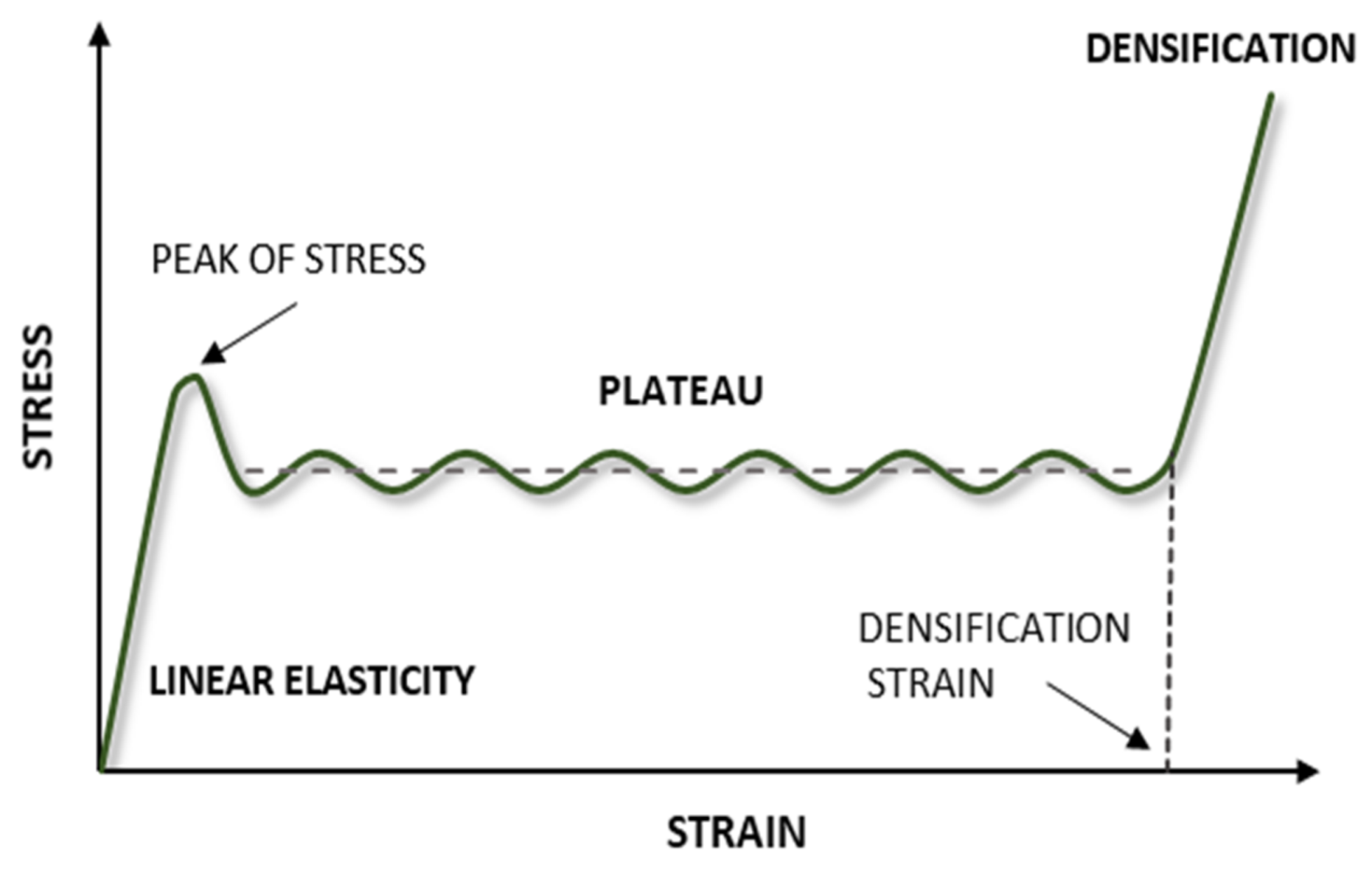
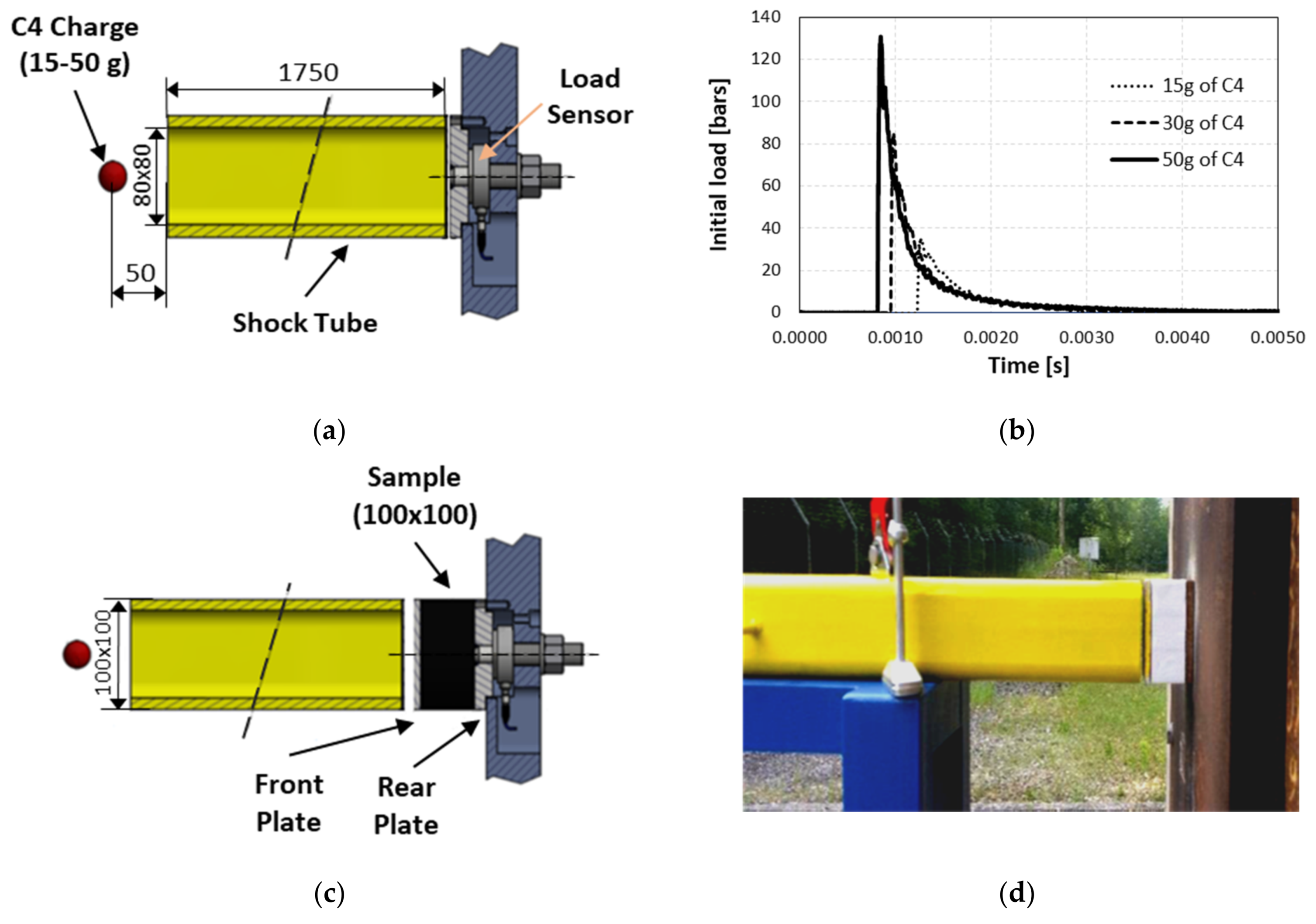

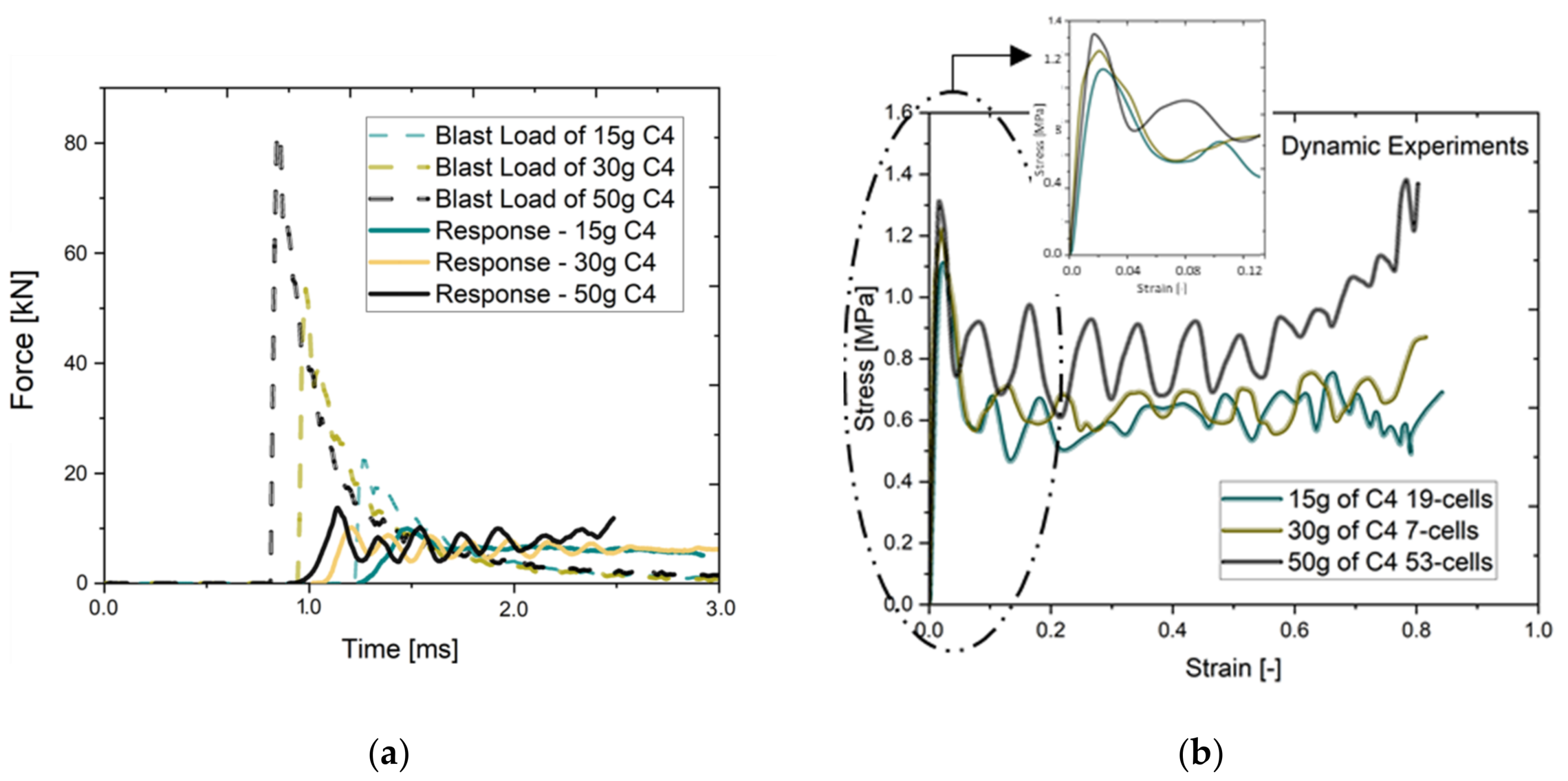
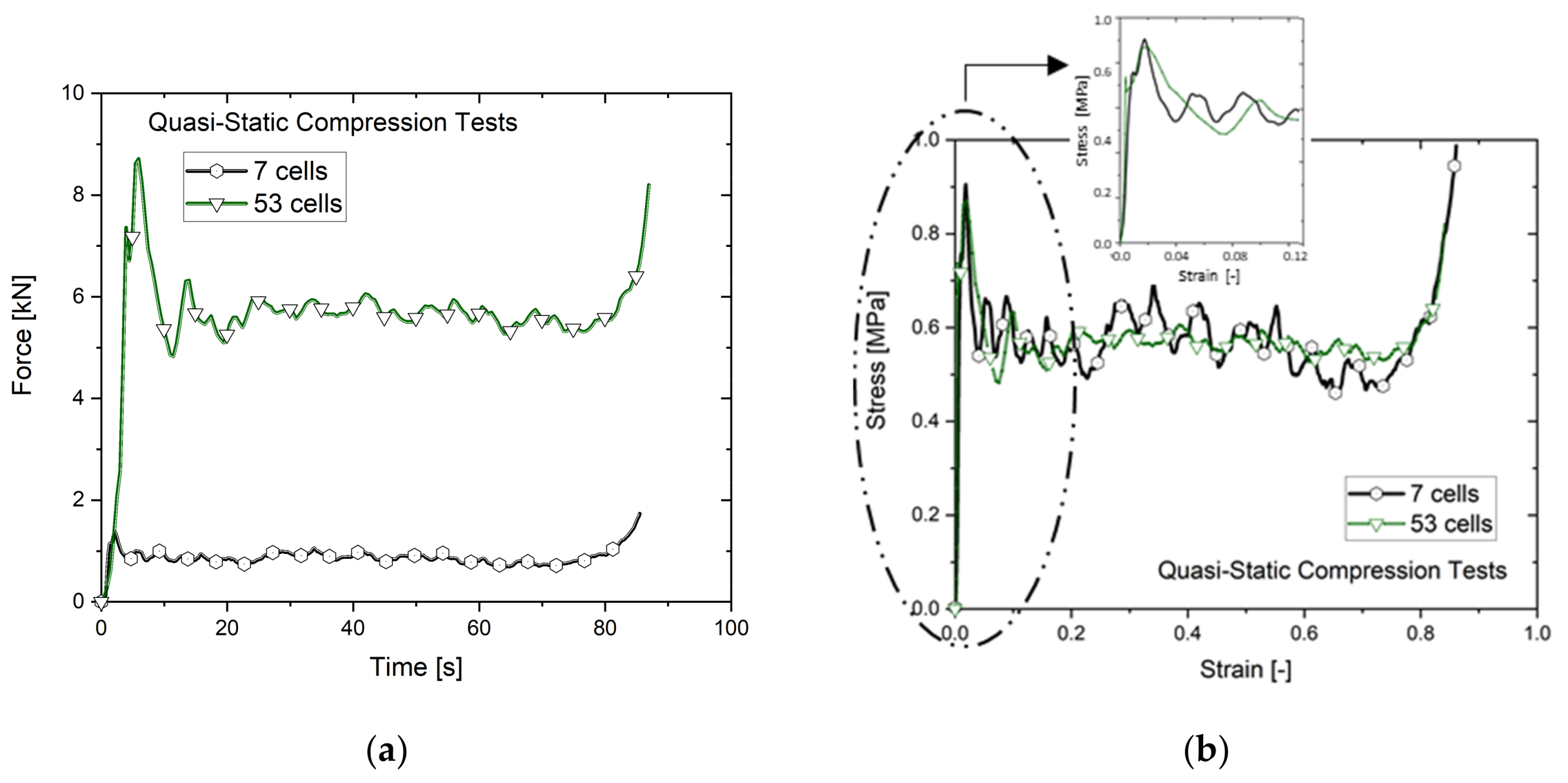

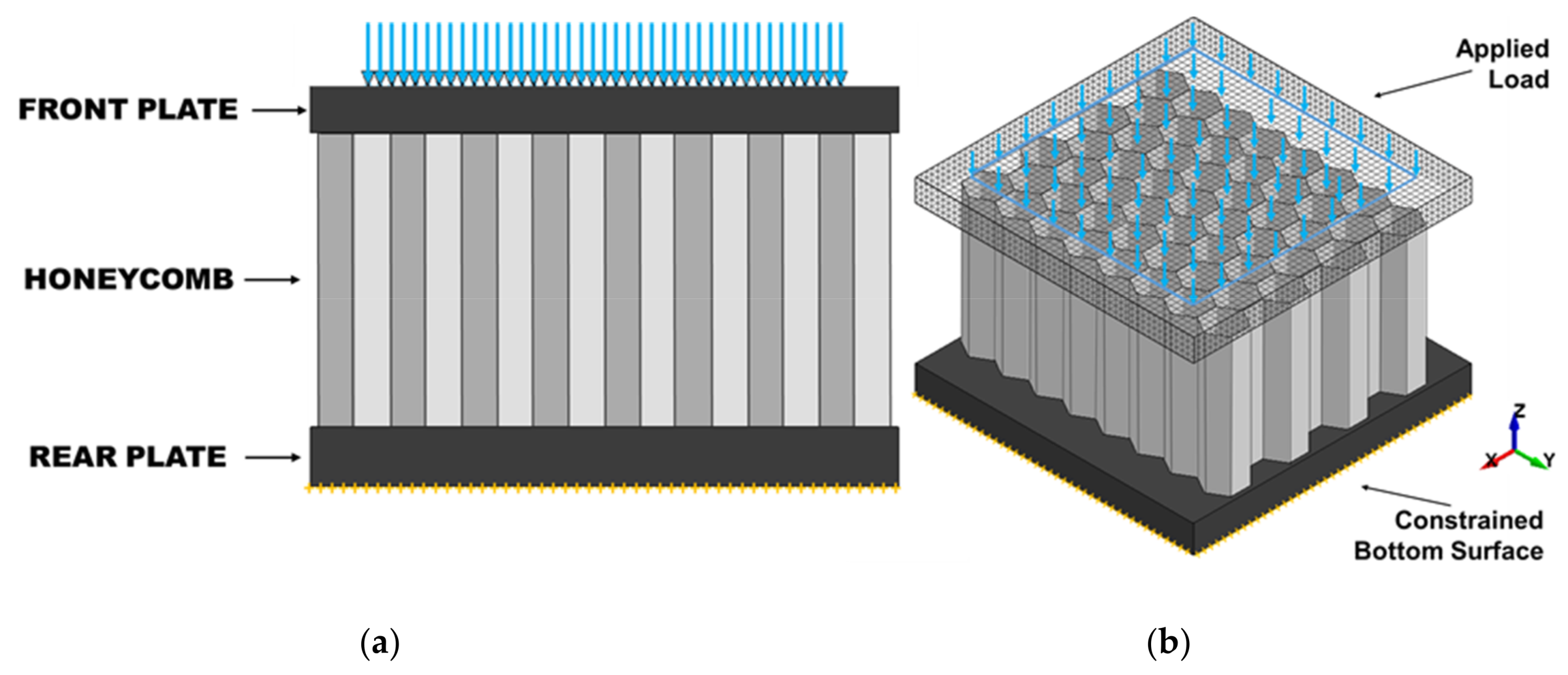
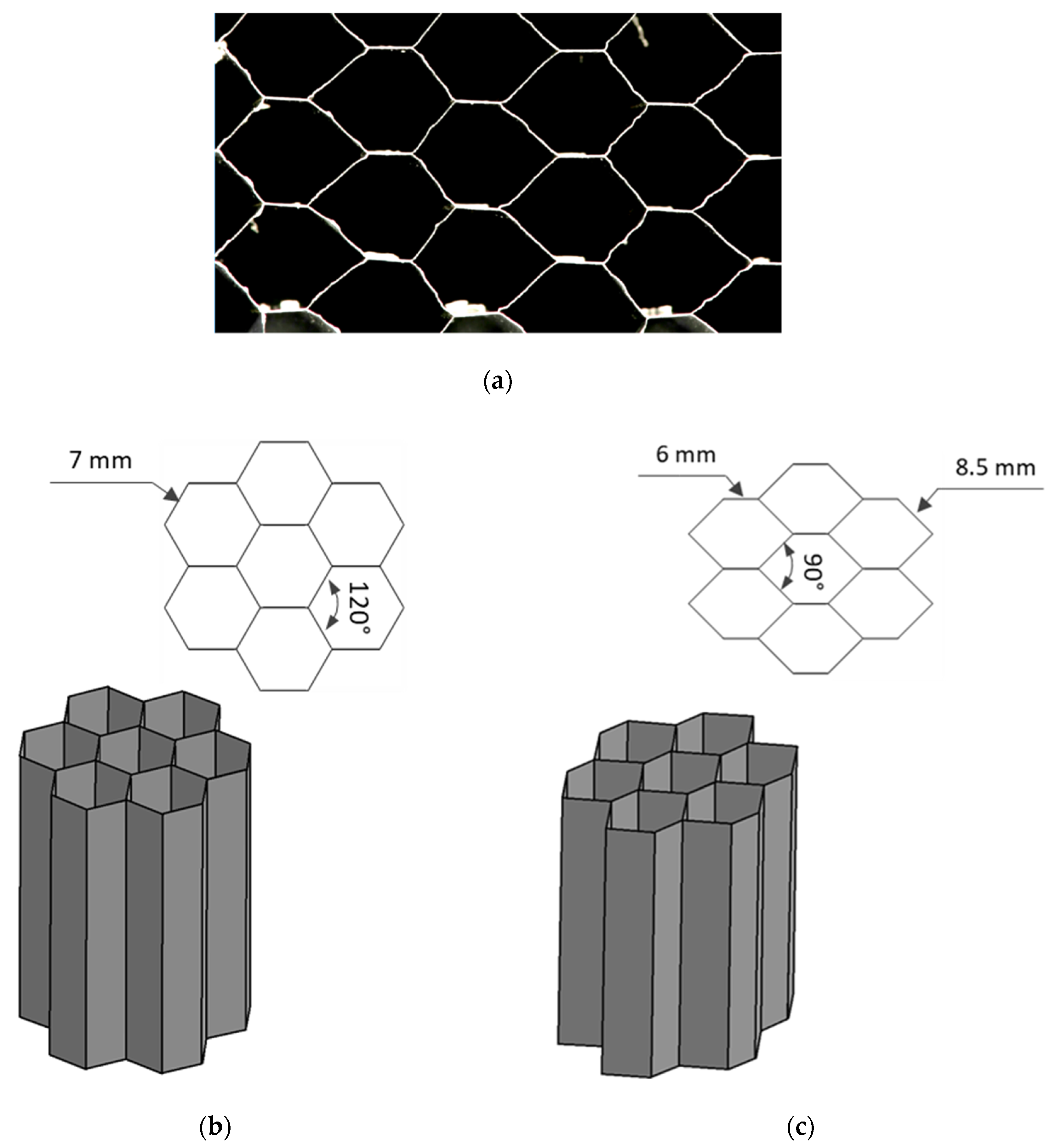
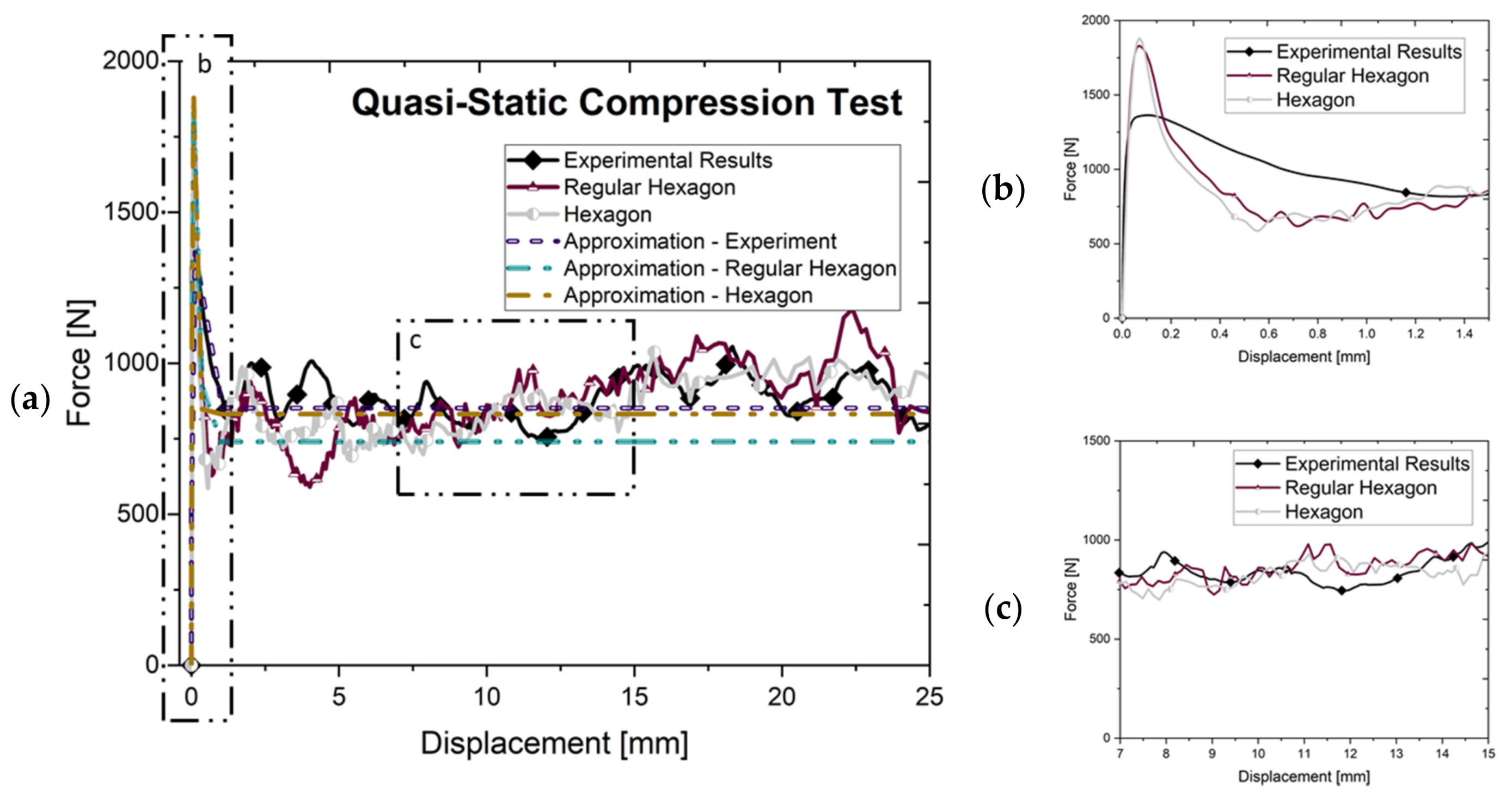


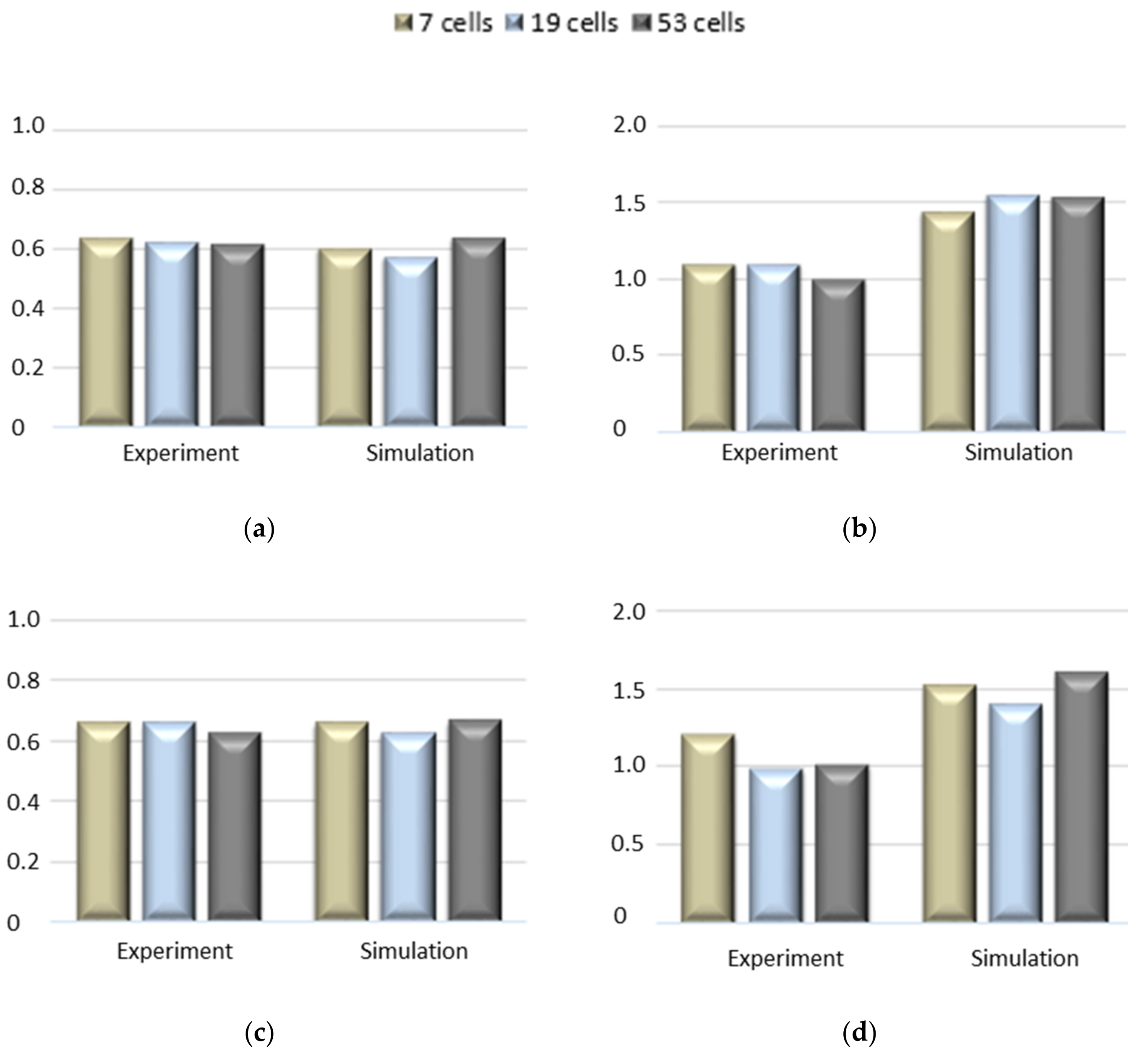

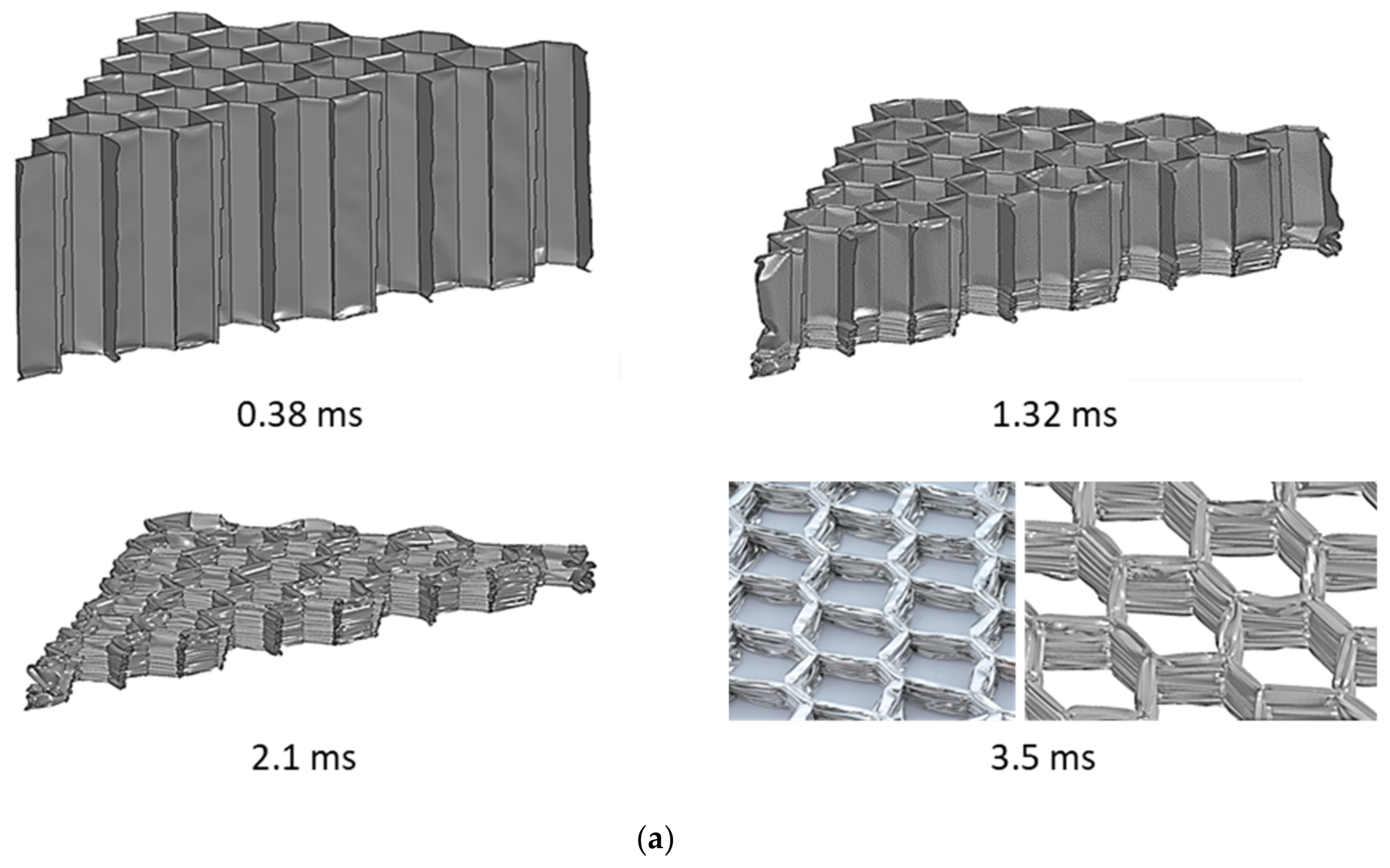
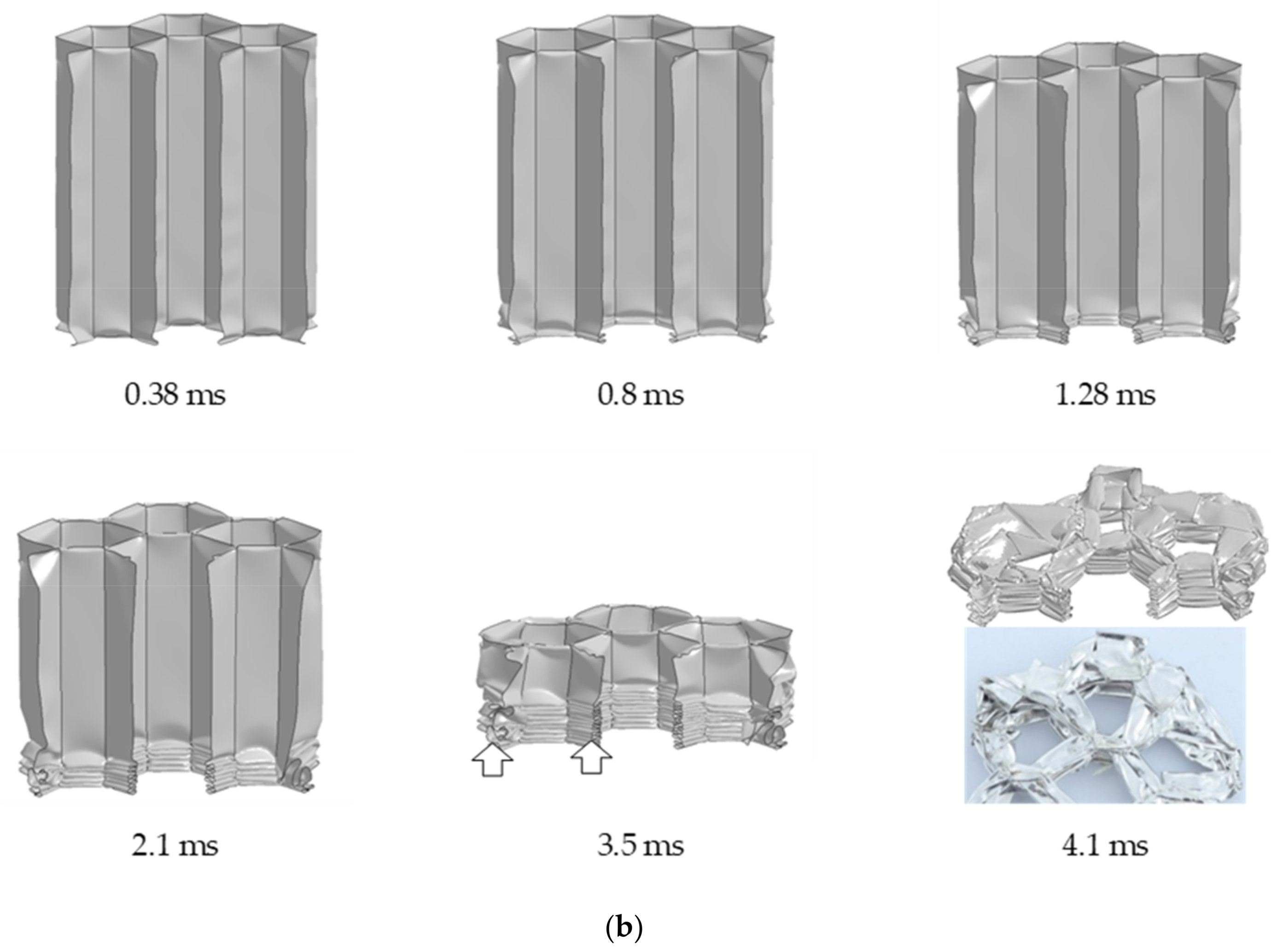

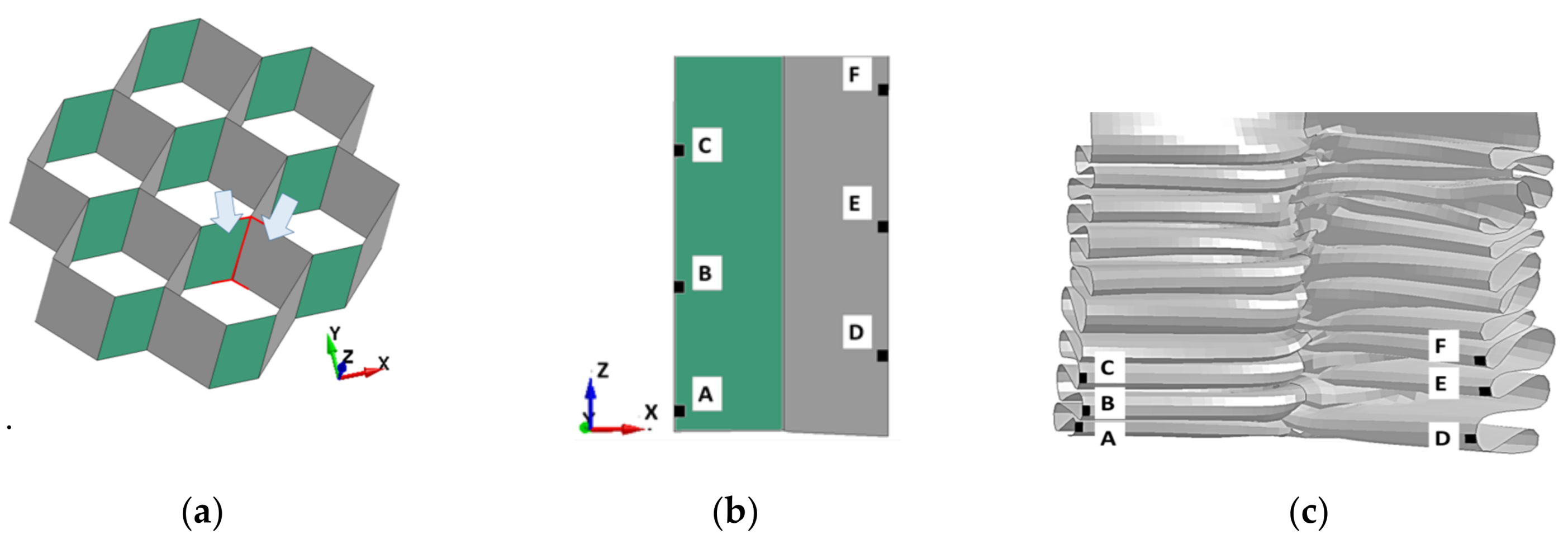
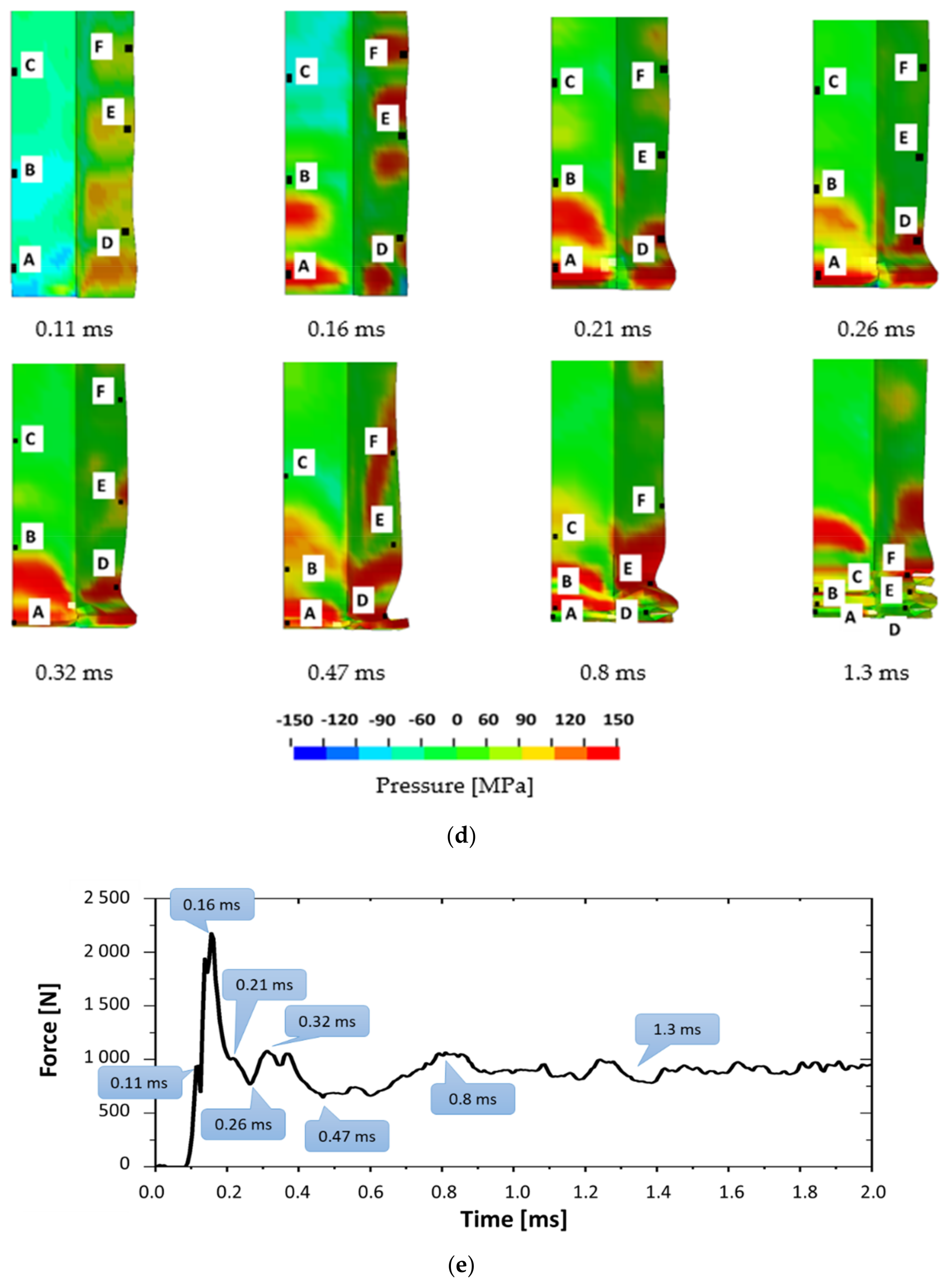
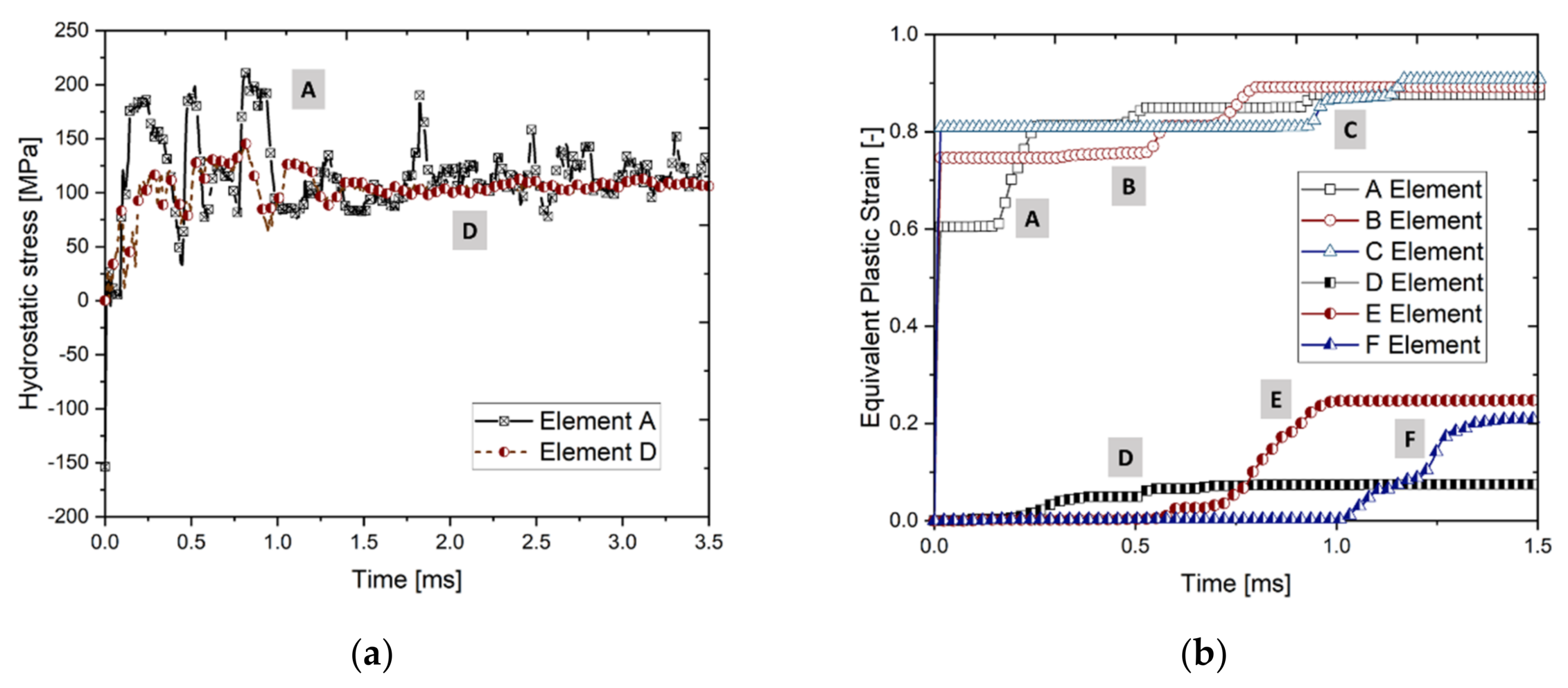
| Structure | 7 Cells | 19 Cells | 53 Cells | ||||||||||
|---|---|---|---|---|---|---|---|---|---|---|---|---|---|
| Load | |||||||||||||
| Quasi-Static | 1.37 | 0.85 | 0.91 | 0.56 | - | - | - | - | 8.85 | 5.63 | 0.88 | 0.56 | |
| 15 g of C4 | 1.66 | 0.96 | 1.10 | 0.64 | 2.74 | 1.55 | 1.10 | 0.62 | 10.0 | 6.19 | 1.00 | 0.62 | |
| 30 g of C4 | 1.83 | 0.99 | 1.21 | 0.66 | 2.48 | 1.64 | 0.99 | 0.66 | 10.2 | 6.26 | 1.02 | 0.63 | |
| 50 g of C4 | - | - | - | - | - | - | - | - | 13.6 | 8.18 | 1.36 | 0.82 | |
| Parameters | Unit | AA3003 | AlSl 4340 [49] |
|---|---|---|---|
| ρ | 2.7 | 7.86 | |
| E | GPa | 70 | 209 |
| A | MPa | 90 | 792 |
| B | MPa | 220 | 510 |
| n | - | 0.2 | 0.26 |
| C | - | 0.001 | 0.014 |
| Friction Coefficients | Set 1 | Set 2 | Set 3 | Set 4 | ||||
|---|---|---|---|---|---|---|---|---|
| Between: | Between: | Between: | Between: | |||||
| Front Plate | Rear Plate | Front Plate | Rear Plate | Front Plate | Rear Plate | Front Plate | Rear Plate | |
| and Structure | and Structure | and Structure | and Structure | |||||
| Dynamic | 0.0 | 0.0 | 0.1 | 0.3 | 0.2 | 0.4 | 0.4 | 0.6 |
| Static | 0.0 | 0.0 | 0.2 | 0.4 | 0.3 | 0.5 | 0.5 | 0.7 |
| Structure | 7 Cells | 19 Cells | 53 Cells | ||||||||||
|---|---|---|---|---|---|---|---|---|---|---|---|---|---|
| Load | |||||||||||||
| E | S | E | S | E | S | E | S | E | S | E | S | ||
| 15 g of C4 | 0.64 | 0.61 | 1.1 | 1.44 | 0.62 | 0.57 | 1.10 | 1.55 | 0.62 | 0.64 | 1.00 | 1.53 | |
| 30 g of C4 | 0.66 | 0.66 | 1.21 | 1.52 | 0.66 | 0.63 | 0.99 | 1.40 | 0.63 | 0.66 | 1.02 | 1.59 | |
| 50 g of C4 | - | 0.71 | - | 1.78 | - | 0.64 | - | 1.43 | 0.82 | 0.71 | 1.36 | 1.37 | |
© 2019 by the authors. Licensee MDPI, Basel, Switzerland. This article is an open access article distributed under the terms and conditions of the Creative Commons Attribution (CC BY) license (http://creativecommons.org/licenses/by/4.0/).
Share and Cite
Stanczak, M.; Fras, T.; Blanc, L.; Pawlowski, P.; Rusinek, A. Blast-Induced Compression of a Thin-Walled Aluminum Honeycomb Structure—Experiment and Modeling. Metals 2019, 9, 1350. https://doi.org/10.3390/met9121350
Stanczak M, Fras T, Blanc L, Pawlowski P, Rusinek A. Blast-Induced Compression of a Thin-Walled Aluminum Honeycomb Structure—Experiment and Modeling. Metals. 2019; 9(12):1350. https://doi.org/10.3390/met9121350
Chicago/Turabian StyleStanczak, Magda, Teresa Fras, Ludovic Blanc, Piotr Pawlowski, and Alexis Rusinek. 2019. "Blast-Induced Compression of a Thin-Walled Aluminum Honeycomb Structure—Experiment and Modeling" Metals 9, no. 12: 1350. https://doi.org/10.3390/met9121350




